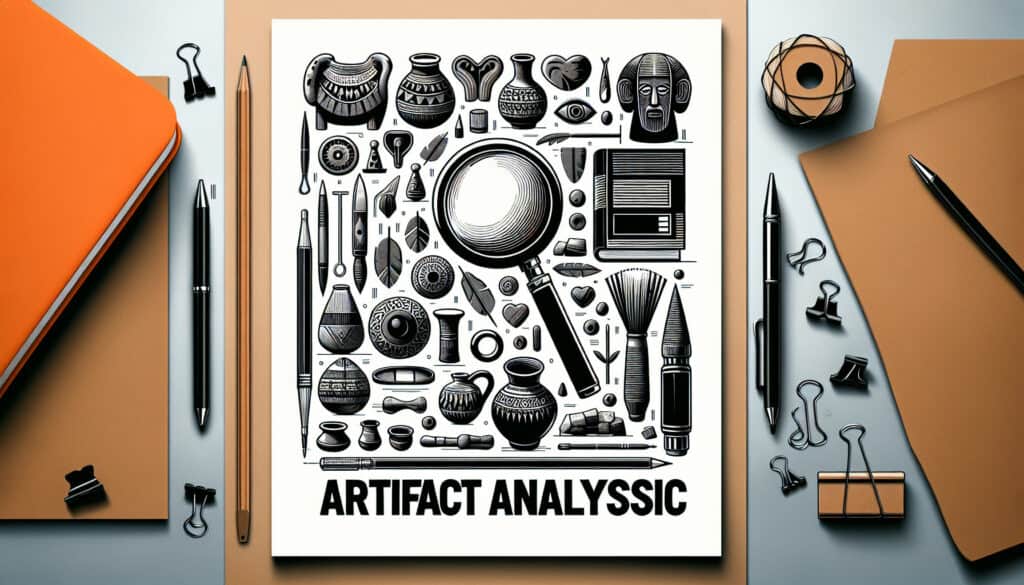A research الطريقة that involves the systematic examination of the material objects or ‘artifacts’ of a culture or group.
- المنهجيات: العملاء والتسويق, لين سيجما, تصميم المنتج
تحليل القطع الأثرية

تحليل القطع الأثرية
- تجربة العملاء, التصميم من أجل الاستدامة, التفكير التصميمي, التفاعل بين الإنسان والحاسوب, التصميم التفاعلي, سهولة الاستخدام, اختبار قابلية الاستخدام, تجربة المستخدم (UX), تصميم يركز على المستخدم
الهدف:
كيفية استخدامه:
- In human-computer interaction and design, artifact analysis is used to understand how people use technology in their everyday lives. By examining the objects that people use, researchers can gain insights into their needs, values, and practices.
الايجابيات
- Provides a rich and contextualized understanding of user behavior, can uncover needs and opportunities that are not revealed by other research methods, and can be used to inform the design of new products and services.
سلبيات
- Can be time-consuming, requires a skilled analyst, and the interpretation of the data can be subjective.
الفئات:
- العملاء والتسويق, تصميم المنتج
الأفضل لـ
- Understanding user behavior and needs by examining the objects they use.
Artifact analysis is commonly employed in various phases of product development, particularly during the early stages of ideation and user research, where understanding real-world interactions with technology is paramount. This methodology is particularly adapted for industries such as consumer electronics, automotive design, and healthcare technology, where user experience significantly influences product success. Participants in artifact analysis typically include designers, anthropologists, usability researchers, and engineers, who collaborate to identify nuanced user behaviors and preferences that inform design choices. One notable application of artifact analysis can be found in the field of healthcare, where analyzing the use of medical devices in clinical settings helps uncover inefficiencies and user pain points that may not be apparent through traditional survey methods. Additionally, this approach can aid in the innovation of smart home technologies by allowing developers to investigate how users interact with household devices like smart speakers and thermostats, thereby revealing opportunities for enhancing integration and usability. By documenting and analyzing the artifacts and contexts of use, teams can develop a more empathetic understanding of user challenges, leading to more effective and تتمحور حول المستخدم design solutions. The in-depth examination of artifacts, combined with observational studies, can also unearth cultural influences on technology adoption, making it an invaluable approach in global product design.
الخطوات الرئيسية لهذه المنهجية
- Identify and select artifacts relevant to the user experience being studied.
- Conduct a detailed examination of the chosen artifacts, focusing on their design, functionality, and context of use.
- Analyze how users interact with the artifacts, including their behaviors, challenges, and satisfaction levels.
- Look for patterns in usage, noting any discrepancies between expected and actual behavior.
- Interpret the findings in relation to user needs, values, and workflows.
- Generate design implications based on the analysis, identifying opportunities for innovation or improvement.
نصائح للمحترفين
- Focus on the social context surrounding artifacts; understanding how communities interact with these objects reveals deeper cultural values and norms.
- Incorporate longitudinal studies in artifact analysis; this approach captures evolving interactions over time and identifies changing user needs.
- Leverage ethnographic techniques alongside artifact analysis; observing users in their natural environments offers nuanced perspectives that enrich the findings.
لقراءة عدة منهجيات ومقارنتها, نوصي باستخدام
> مستودع المنهجيات الشامل <
مع أكثر من 400 منهجية أخرى.
نرحب بتعليقاتكم على هذه المنهجية أو المعلومات الإضافية على قسم التعليقات أدناه ↓، وكذلك أي أفكار أو روابط متعلقة بالهندسة.
السياق التاريخي
1986
(إذا كان التاريخ غير معروف أو غير ذي صلة، على سبيل المثال "ميكانيكا الموائع"، يتم تقديم تقدير تقريبي لظهوره الملحوظ)

منشورات ذات صلة
استبيانات الانزعاج العضلي الهيكلي
الاختبار متعدد المتغيرات (MVT)
تحليل الانحدار المتعدد
أنظمة التقاط الحركة
طريقة MoSCoW
اختبار متوسط المزاج